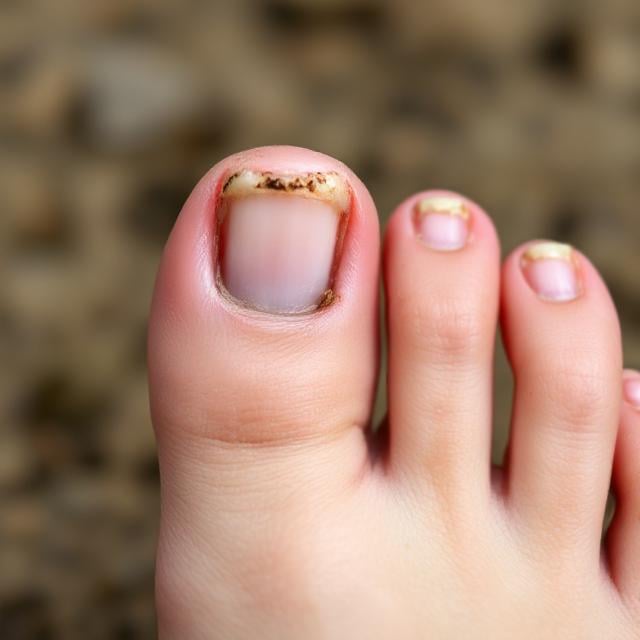Have you ever noticed thick, discolored, or brittle nails and wondered what might be causing them? One common culprit is onychomycosis, a fungal infection of the nails. While it may seem like a minor cosmetic issue, it can actually lead to discomfort, pain, and complications if left untreated. Let’s explore what onychomycosis is, why it happens, how to recognize it, and what can be done to treat and prevent it.
What Is Onychomycosis?
Onychomycosis is a fungal infection that affects the toenails or fingernails, although it’s more common in toenails. It’s caused by fungi known as dermatophytes, but yeasts and molds can also be responsible (Gupta et al., 2020). These fungi thrive in warm, moist environments, which makes places like locker rooms, swimming pools, and even tight shoes ideal for their growth.
The infection starts slowly, often affecting just one nail, and can spread if not treated. It can cause the nail to become discolored usually yellow, white, or brown and change in texture and shape. Over time, the nail may become thick, brittle, or even separate from the nail bed.
Who Is at Risk?
Anyone can get onychomycosis, but certain factors increase the risk. These include:
- Aging (reduced blood flow and slower nail growth)
- Sweaty feet or frequent damp conditions
- Walking barefoot in communal areas
- Nail injuries or skin conditions like psoriasis
- Diabetes, poor circulation, or a weakened immune system (Lipner & Scher, 2019)
Men are more likely to be affected than women, and it is more common in older adults.
Symptoms of Onychomycosis
The symptoms may vary depending on the type of fungus and severity of the infection. Common signs include:
- Discoloration of the nail (white, yellow, brown, or black)
- Thickening or crumbling edges
- Distorted nail shape
- A foul smell from the infected nail
- Pain or discomfort, especially when walking (Elewski et al., 2020)
Because the symptoms can resemble other nail problems, such as psoriasis or injury, it’s important to get a proper diagnosis from a healthcare provider.
Diagnosis and Testing
Doctors usually diagnose onychomycosis through physical examination and confirm it with tests. A small piece of the nail may be taken and examined under a microscope or cultured to identify the type of fungus (Gupta & Versteeg, 2017). Accurate diagnosis helps choose the best treatment.
Treatment Options
Treating onychomycosis can be a long process, and the results are not instant. Options include:
- Topical Treatments: These include antifungal nail creams or medicated nail lacquers. They are generally used for mild cases but often have limited success if the infection is deep in the nail.
- Oral Antifungal Medications: Drugs like terbinafine and itraconazole are commonly prescribed for more serious cases. They work faster and more effectively but may have side effects and require blood tests to monitor liver function (Gupta et al., 2020).
- Laser Therapy: This newer method uses light to kill fungi in the nail. It’s safe but can be expensive and is not always covered by insurance.
- Nail Removal: In very severe cases, the entire nail may be removed to allow direct treatment to the nail bed.
Even with treatment, it can take months for a healthy nail to grow out completely. And recurrence is possible, so good foot hygiene is key.
Prevention
Preventing onychomycosis is often easier than treating it. Here are some tips:
- Keep feet clean and dry
- Wear breathable footwear and moisture-wicking socks
- Avoid walking barefoot in public places
- Don’t share nail clippers or footwear
- Trim nails straight across and avoid injuring them
For people with diabetes or circulation problems, routine foot care is especially important.
Onychomycosis might seem like just a cosmetic nuisance, but it’s a real infection that can affect your comfort and health. The good news is that with proper diagnosis and treatment, it can be managed effectively. If you notice any changes in your nails, don’t ignore them early treatment can make a big difference.
References
- Elewski, B. E., Ghannoum, M. A., & Gibb, T. (2020). Onychomycosis: Pathogenesis, diagnosis, and management. Clinical Microbiology Reviews, 33(1), e00041-19. https://doi.org/10.1128/CMR.00041-19
- Gupta, A. K., Foley, K. A., & Versteeg, S. G. (2020). New developments in onychomycosis treatment and diagnosis. Journal of Fungi, 6(4), 248. https://doi.org/10.3390/jof6040248
- Gupta, A. K., & Versteeg, S. G. (2017). A critical review of improvement rates for topical antifungal treatments of onychomycosis. Journal of Cutaneous Medicine and Surgery, 21(4), 326-338. https://doi.org/10.1177/1203475417704954
- Lipner, S. R., & Scher, R. K. (2019). Onychomycosis: Clinical overview and diagnosis. Journal of the American Academy of Dermatology, 80(4), 835-851. https://doi.org/10.1016/j.jaad.2018.03.049











